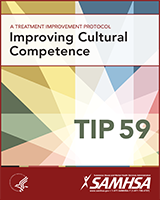NCBI Bookshelf. A service of the National Library of Medicine, National Institutes of Health.
Excerpt
The development of culturally responsive clinical skills is vital to the effectiveness of behavioral health services. According to the U. S. Department of Health and Human Services (HHS), cultural competence “refers to the ability to honor and respect the beliefs, languages, interpersonal styles, and behaviors of individuals and families receiving services, as well as staff members who are providing such services. Cultural competence is a dynamic, ongoing developmental process that requires a long-term commitment and is achieved over time” (HHS 2003a, p. 12). It has also been called “a set of behaviors, attitudes, and policies that … enable a system, agency, or group of professionals to work effectively in cross-cultural situations” (Cross et al. 1989, p. 13).
This Treatment Improvement Protocol (TIP) uses Sue's (2001) multidimensional model for developing cultural competence. Adapted to address cultural competence across behavioral health settings, this model serves as a framework for targeting three organizational levels of treatment: individual counselor and staff, clinical and programmatic, and organizational and administrative. The chapters target specific racial, ethnic, and cultural considerations along with the core elements of cultural competence highlighted in the model. These core elements include cultural awareness, general cultural knowledge, cultural knowledge of behavioral health, and cultural skill development. The primary objective of this TIP is to assist readers in understanding the role of culture in the delivery of behavioral health services (both generally and with reference to specific cultural groups). This TIP is organized into six chapters and begins with an introduction to cultural competence. The following subheadings provide a summary of each chapter and an overview of this publication.
Contents
- Consensus Panel
- KAP Expert Panel and Federal Government Participants
- What Is a TIP?
- Foreword
- Executive Summary
- 1. Introduction to Cultural Competence
- Purpose and Objectives of the TIP
- Core Assumptions
- What Is Cultural Competence?
- Why Is Cultural Competence Important?
- How Is Cultural Competence Achieved?
- What Is Culture?
- What Is Race?
- What Is Ethnicity?
- What Is Cultural Identity?
- What Are the Cross-Cutting Factors in Race, Ethnicity, and Culture?
- As You Proceed
- 2. Core Competencies for Counselors and Other Clinical Staff
- 3. Culturally Responsive Evaluation and Treatment Planning
- Step 1. Engage Clients
- Step 2. Familiarize Clients and Their Families With Treatment and Evaluation Processes
- Step 3. Endorse Collaboration in Interviews, Assessments, and Treatment Planning
- Step 4. Integrate Culturally Relevant Information and Themes
- Step 5. Gather Culturally Relevant Collateral Information
- Step 6. Select Culturally Appropriate Screening and Assessment Tools
- Step 7. Determine Readiness and Motivation for Change
- Step 8. Provide Culturally Responsive Case Management
- Step 9. Incorporate Cultural Factors Into Treatment Planning
- 4. Pursuing Organizational Cultural Competence
- 5. Behavioral Health Treatment for Major Racial and Ethnic Groups
- 6. Drug Cultures and the Culture of Recovery
- Appendix A. Bibliography
- Appendix B. Instruments To Measure Identity and Acculturation
- Appendix C. Tools for Assessing Cultural Competence
- Appendix D. Screening and Assessment Instruments
- Appendix E. Cultural Formulation in Diagnosis and Cultural Concepts of Distress
- Appendix F. Cultural Resources
- Appendix G. Glossary
- Appendix H. Resource Panel
- Appendix I. Cultural Competence and Diversity Network Participants
- Appendix J. Field Reviewers
- Appendix K. Acknowledgments
Suggested citation:
Substance Abuse and Mental Health Services Administration. Improving Cultural Competence. Treatment Improvement Protocol (TIP) Series No. 59. HHS Publication No. (SMA) 14-4849. Rockville, MD: Substance Abuse and Mental Health Services Administration, 2014.
The views, opinions, and content expressed herein are those of the consensus panel and do not necessarily reflect the views, opinions, or policies of SAMHSA or HHS. No official support of or endorsement by SAMHSA or HHS for these opinions or for particular instruments, software, or resources is intended or should be inferred.
- NLM CatalogRelated NLM Catalog Entries
- Review Improving Cultural Competence to Reduce Health Disparities[ 2016]Review Improving Cultural Competence to Reduce Health DisparitiesButler M, McCreedy E, Schwer N, Burgess D, Call K, Przedworski J, Rosser S, Larson S, Allen M, Fu S, et al. 2016 Mar
- Review Treatment of culturally diverse children and adolescents with depression.[J Child Adolesc Psychopharmaco...]Review Treatment of culturally diverse children and adolescents with depression.Stewart SM, Simmons A, Habibpour E. J Child Adolesc Psychopharmacol. 2012 Feb; 22(1):72-9. Epub 2012 Jan 17.
- Cultural consultation as a model for training multidisciplinary mental healthcare professionals in cultural competence skills: preliminary results.[J Psychiatr Ment Health Nurs. ...]Cultural consultation as a model for training multidisciplinary mental healthcare professionals in cultural competence skills: preliminary results.Owiti JA, Ajaz A, Ascoli M, de Jongh B, Palinski A, Bhui KS. J Psychiatr Ment Health Nurs. 2014; 21(9):814-26. Epub 2013 Nov 27.
- Review Culture of Care: Organizational Responsibilities.[Management of Animal Care and ...]Review Culture of Care: Organizational Responsibilities.Brown MJ, Symonowicz C, Medina LV, Bratcher NA, Buckmaster CA, Klein H, Anderson LC. Management of Animal Care and Use Programs in Research, Education, and Testing. 2018
- The patient experience of patient-centered communication with nurses in the hospital setting: a qualitative systematic review protocol.[JBI Database System Rev Implem...]The patient experience of patient-centered communication with nurses in the hospital setting: a qualitative systematic review protocol.Newell S, Jordan Z. JBI Database System Rev Implement Rep. 2015 Jan; 13(1):76-87.
- Improving Cultural CompetenceImproving Cultural Competence
Your browsing activity is empty.
Activity recording is turned off.
See more...
